When it comes to achieving the hair of your dreams, wigs and hairpieces offer endless possibilities. With a wide variety of options available, it’s important to understand the different types of wigs and hairpieces to choose the perfect one for you. Whether you’re looking for a complete hair transformation or just a little extra volume, this comprehensive guide will help you navigate through the world of wig types and hairpiece styles.
From synthetic wigs to human hair wigs, lace front wigs to monofilament wigs, each type has its own unique features and benefits. Understanding the differences between them will empower you to make an informed decision based on your preferences and needs.
Get ready to explore the wonderful world of wigs and hairpieces, where the possibilities are endless and the perfect style is just waiting to be discovered.
Key Takeaways:
- There are different types of wigs and hairpieces available, such as synthetic wigs, human hair wigs, lace front wigs, full lace wigs, heat resistant wigs, and monofilament wigs.
- Human hair wigs offer a natural look and feel but require extra care and maintenance.
- Synthetic wigs are more affordable and hold their styles better, making them a great option for those on a budget.
- Wig cap construction plays a crucial role in comfort and security, with options like lace front wigs, full lace wigs, U-part wigs, and monofilament caps.
- Indian human hair is considered the best for wigs, while virgin hair and Remy hair offer additional quality options.
Understanding Human Hair Wigs
When it comes to achieving a natural and versatile look, human hair wigs are the go-to choice. Made from 100% natural hair, these wigs offer a soft and glossy texture that closely mimics real hair. With human hair wigs, you can confidently style your hair in various ways, just like you would with your own hair.
One of the key advantages of human hair wigs is their ability to provide a truly natural look and feel. The strands of hair are carefully sourced, ensuring high-quality and authenticity. This makes human hair wigs highly coveted among wig wearers who value a realistic appearance.
Human hair wigs are also known for their durability. With proper care and maintenance, these wigs can last for a long time, allowing you to enjoy their beauty and versatility for years to come. They are well-suited for regular use and can withstand heat styling tools, such as curling irons and straighteners.
However, it’s important to note that human hair wigs require extra care and maintenance compared to synthetic wigs. Human hair has a tendency to tangle more easily, requiring gentle brushing and detangling to maintain its smoothness. Additionally, since human hair wigs are made from natural hair, they may require occasional deep conditioning treatments to keep them looking and feeling their best.
The cost of human hair wigs can vary depending on various factors such as the origin of the hair, grade, length, cap construction, texture, density, and styling. Higher-quality human hair wigs, such as those made from European or Brazilian hair, tend to be more expensive. Additionally, features like custom styling and increased hair density can also contribute to the overall cost.
Advantages of Human Hair Wigs:
- Natural look and feel
- Durable and long-lasting
- Can be heat styled
Disadvantages of Human Hair Wigs:
- Require extra care and maintenance
- Tend to tangle more easily
- Can be more expensive compared to synthetic wigs
I love how human hair wigs allow me to achieve the most natural look. The soft texture and versatility make them my top choice for any occasion. However, proper care and maintenance are essential to keep them looking their best.
Exploring Synthetic Wigs
Synthetic wigs offer a budget-friendly alternative to human hair wigs. Made from man-made fibers, these wigs provide numerous benefits for those seeking ready-to-wear styles. Although they may lack the natural shine and durability of human hair wigs, synthetic wigs have their own unique advantages.
One of the key advantages of synthetic wigs is their ability to hold their styles better and longer. The synthetic fibers used in these wigs are designed to maintain their shape and form, reducing the need for constant restyling. Whether you prefer curls, waves, or straight styles, synthetic wigs can effortlessly keep their desired look without much effort.
Moreover, synthetic wigs come in a wide range of colors, allowing for endless possibilities in achieving your desired aesthetic. Whether you want to experiment with bold and vibrant shades or prefer more natural tones, you can easily find a synthetic wig that matches your style and personality.
While synthetic wigs offer affordability and versatility, it’s important to note that they may not provide the same level of durability as human hair wigs. The synthetic fibers can be more prone to frizzing, tangling, and heat damage, requiring proper care and maintenance. With the right care routine, however, synthetic wigs can last for a significant amount of time.
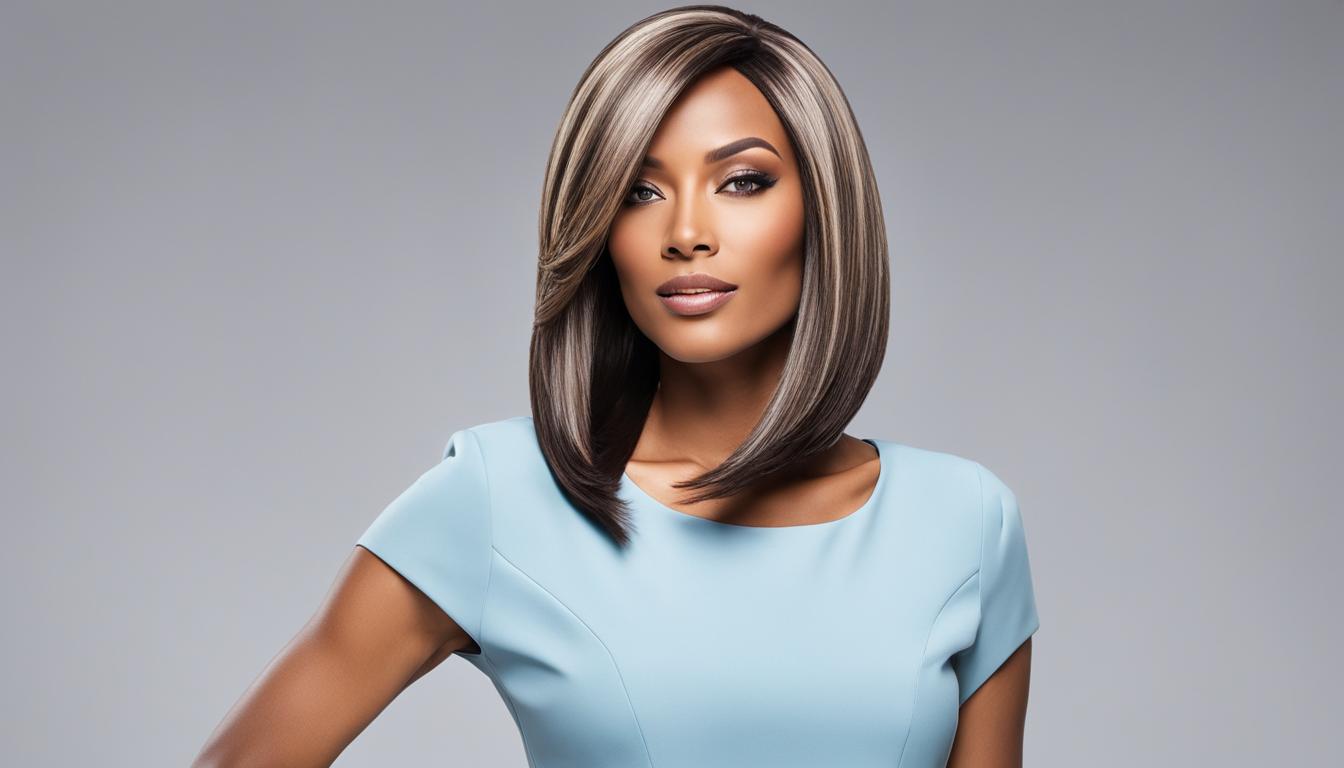
In summary, synthetic wigs are a great option for individuals on a budget or those who prefer ready-to-wear styles. They hold their styles well, come in a wide range of colors, and can be a long-lasting choice with proper care. Whether you’re looking for a wig for everyday use or a fun addition to your collection, synthetic wigs offer a convenient and affordable solution.
Unveiling Different Wig Cap Constructions
When it comes to finding the perfect wig, the cap construction is an essential factor to consider. The cap construction determines the comfort, fit, and security of the wig, making it a crucial element in achieving a natural look. Let’s explore the different wig cap constructions available and their unique features.
Lace Front Wigs
Lace front wigs feature an undetectable lace mesh along the hairline, providing a seamless blend with the wearer’s natural hair. The lace front allows for versatile styling options, such as pulling the hair away from the face. This construction offers a natural-looking hairline and is a popular choice among wig wearers.
Full Lace Wigs
Full lace wigs have a sheer lace material that extends throughout the entire cap, providing maximum versatility in styling. The entire wig can be parted in any direction, offering unlimited possibilities for updos, ponytails, and other intricate styles. Full lace wigs give the appearance of natural hair growth and allow for a seamless transition between the wig and the scalp.
U-Part Wigs
U-part wigs are designed to blend seamlessly with the wearer’s natural hair, providing a natural-looking hairline and part. These wigs feature a U-shaped opening in the front, allowing the wearer to leave out a small section of their own hair for a perfect blend. U-part wigs are an excellent choice for those who want to add volume and length while maintaining the appearance of their natural hair.
Monofilament Caps
Monofilament caps provide the most natural-looking hairpieces on the market. The cap is constructed with a thin, breathable material that mimics the look of the scalp. Each hair strand is hand-tied onto the cap, allowing for realistic movement and parting in any direction. Monofilament caps are ideal for individuals who prioritize a natural appearance and comfort.
Choosing the right wig cap construction is crucial for achieving the desired look and comfort. Whether you prefer the versatility of lace front wigs, the freedom of full lace wigs, the natural blend of U-part wigs, or the realism of monofilament caps, there is a wig cap construction that will suit your needs. Find the perfect match to enhance your style and confidence.
Exploring Different Hair Types for Wigs
When it comes to creating the perfect wig, understanding the different hair types is essential. Let’s delve into the world of hair types for wigs, including Indian human hair, virgin hair, Remy hair, and non-Remy hair.
Indian Human Hair
Indian human hair is widely regarded as the top choice for wigs due to its exceptional quality. Known for its thickness, lustrousness, and resilience, Indian human hair provides a natural and realistic look. Whether you’re seeking a straight, wavy, or curly wig, Indian human hair can deliver the desired style with ease.
Virgin Hair
For those looking for the purest and most authentic hair, virgin hair wigs are the answer. Made from 100% real human hair that hasn’t undergone any chemical processes, virgin hair wigs offer unmatched quality and versatility. With virgin hair, you have the freedom to dye, bleach, and style the wig just like your own natural hair.
Remy Hair
Remy hair wigs are another popular choice among wig enthusiasts. The distinguishing feature of Remy hair is that all the cuticles are aligned in a single direction, providing a sleek and natural appearance. This alignment also allows for easy styling and prevents matting and tangling. Remy hair wigs offer superior quality and longevity, ensuring a long-lasting and realistic wig experience.
Non-Remy Hair
Non-Remy hair wigs, as the name suggests, are made from hair collected from multiple donors. This hair may undergo chemical treatment to achieve a specific texture or color. While non-Remy hair wigs are more affordable, they may be prone to tangling and shedding, as the cuticles are not aligned in a single direction. However, with proper care and maintenance, non-Remy hair wigs can still offer a stylish and budget-friendly option.
Now that we’ve explored the different hair types for wigs, you can make an informed decision based on your preferences, budget, and desired style. Whether you choose Indian human hair, virgin hair, Remy hair, or non-Remy hair, you can confidently rock a stunning wig that suits your unique personality.
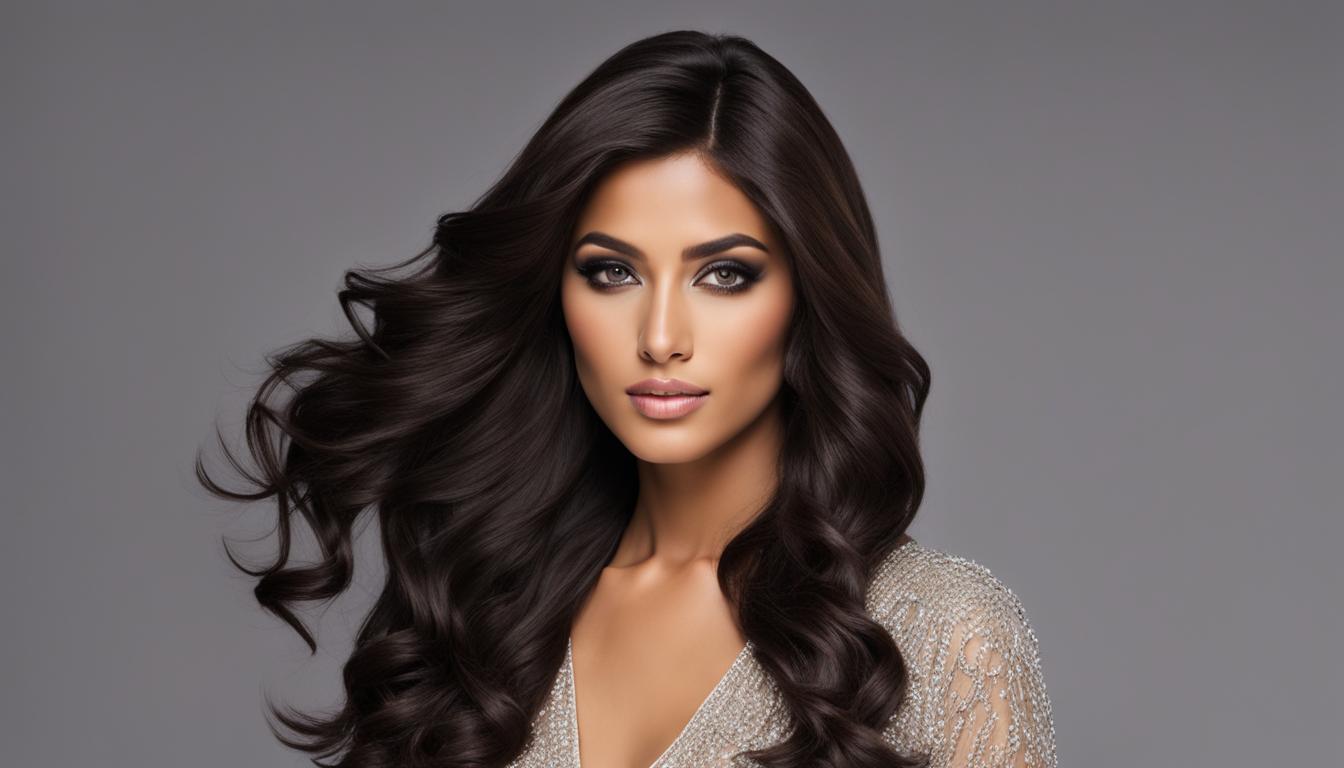
Considering Length and Texture of Wigs
When choosing a wig, it’s essential to consider both the length and texture to achieve the desired style. Different lengths and textures offer various looks and suit different body types, allowing you to express your unique personality and enhance your overall appearance.
Choosing the Right Wig Length
The length of a wig can drastically change your look, so it’s crucial to choose one that complements your features and suits your personal style. Wigs come in various lengths, ranging from below the ear to waist length. Below are some common wig lengths and the effects they create:
- Short Length (below the ear to shoulder length): Short wigs are versatile and require minimal maintenance. They offer a fresh and youthful look, ideal for those who prefer a chic and modern style.
- Medium Length (shoulder length to mid-back length): Medium length wigs strike a balance between short and long hair. They provide room for different styling options, including updos and half-up hairstyles.
- Long Length (mid-back length to waist length): Long wigs create a dramatic and glamorous look, perfect for special occasions or if you want to make a bold fashion statement.
When selecting a wig length, consider your face shape, body type, and the image you want to project. A professional stylist or wig specialist can help you determine the most flattering length for you.
Understanding Wig Texture
Wig texture refers to the natural appearance and feel of the hair. There are three common wig textures:
- Straight Texture: Straight wigs offer a sleek and polished look. They are more likely to appear as the indicated length since the hair lies flat and doesn’t add extra volume.
- Wavy Texture: Wavy wigs have a subtle wave pattern that adds a touch of femininity and softness. Due to the texture, wavy wigs may appear slightly shorter than their actual length.
- Curly Texture: Curly wigs feature defined curls or loose waves that create volume and bounce. The curls can make the wig appear shorter than its stated length.
The choice of wig texture depends on personal preference and the style you want to achieve. Experimenting with different textures can help you find the look that suits you best.
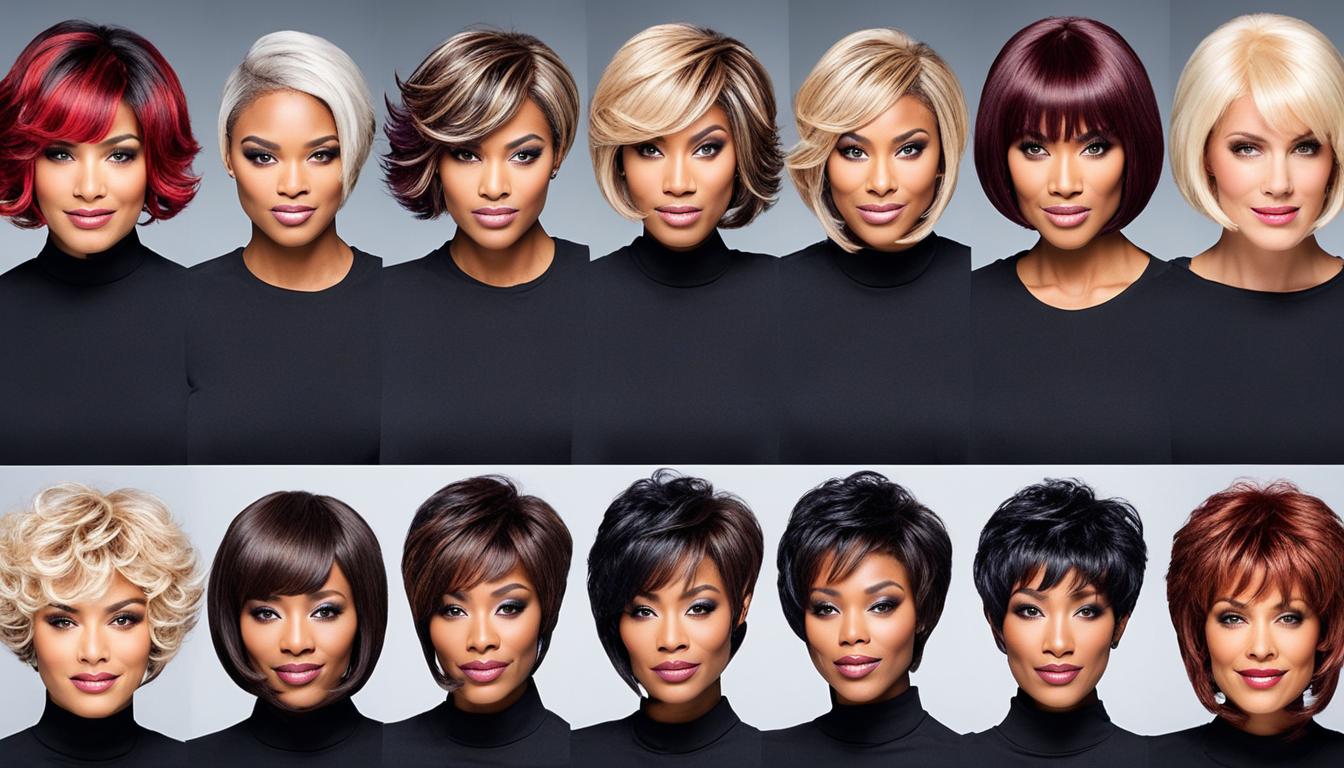
With the right length and texture, you can transform your appearance and confidence. Consider your body type, face shape, and personal style when selecting the perfect wig. Whether you opt for a short straight bob or a long curly mane, the right wig length and texture will help you achieve your desired look.
Pros and Cons of Human Hair vs. Synthetic Hair Wigs
When it comes to choosing the right wig, there are two main options to consider: human hair wigs and synthetic hair wigs. Each type has its own set of advantages and disadvantages, allowing individuals to make an informed decision based on their preferences and budget.
Human Hair Wigs
Human hair wigs offer a natural and authentic look that closely resembles real hair. They are made from 100% natural human hair, allowing for versatile styling options like heat styling and coloring. With proper care, these wigs can last for a long time, making them a worthwhile investment.
However, it’s worth noting that human hair wigs require more care and maintenance compared to synthetic hair wigs. They can tangle easily and may lose their style in humid conditions. Additionally, human hair wigs tend to be more expensive due to the cost of sourcing and processing the hair.
Synthetic Hair Wigs
Synthetic hair wigs, on the other hand, are more affordable and require less maintenance compared to human hair wigs. They come pre-styled and hold their shape well, even in humid weather conditions. With advancements in technology, synthetic hair wigs now offer a more natural look and feel.
However, synthetic hair wigs lack the natural shine and durability of human hair wigs. They cannot be heat styled or colored, limiting styling options. Additionally, synthetic hair wigs have a shorter lifespan and may need to be replaced more frequently.
Ultimately, the choice between human hair wigs and synthetic hair wigs depends on personal preferences and budget. If you prioritize a natural look and the ability to style and color the wig, human hair wigs may be the better option for you. On the other hand, if affordability and low maintenance are your priorities, synthetic hair wigs can be a great choice.
Whichever type of wig you choose, it’s important to consider your individual needs and lifestyle to ensure you find the perfect match.
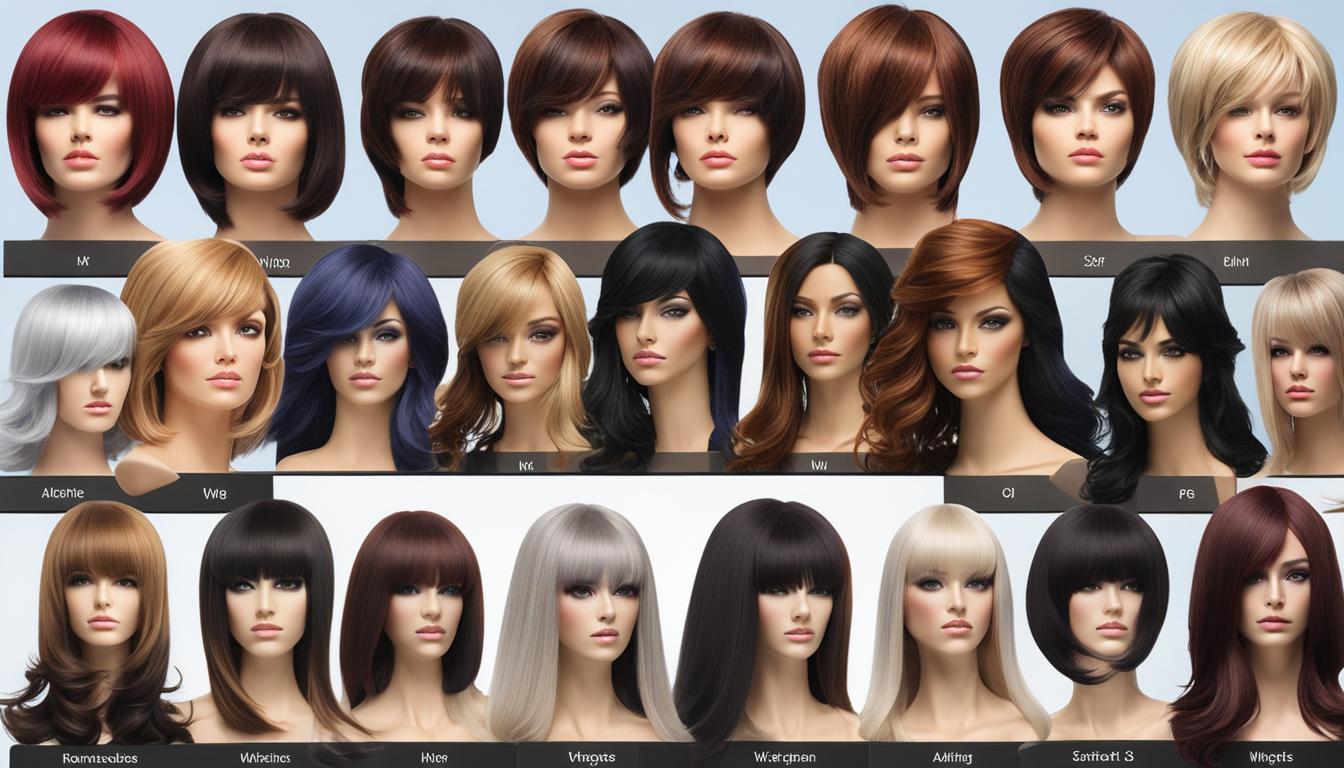
| Human Hair Wigs | Synthetic Hair Wigs |
|---|---|
| Natural and authentic look | More affordable |
| Ability to be heat styled and colored | Low maintenance |
| Requires more care and maintenance | Lacks natural shine and durability |
| Longer lifespan | Cannot be heat styled or colored |
The Benefits and Drawbacks of Lace Wigs
Lace wigs, including lace front wigs and full lace wigs, offer a natural and undetectable hairline. They provide versatility in styling and allow for various hairstyles, such as updos and ponytails. Lace wigs are made with a sheer lace base, giving the appearance of hair growing directly from the scalp. This creates a seamless look that is hard to distinguish from natural hair.
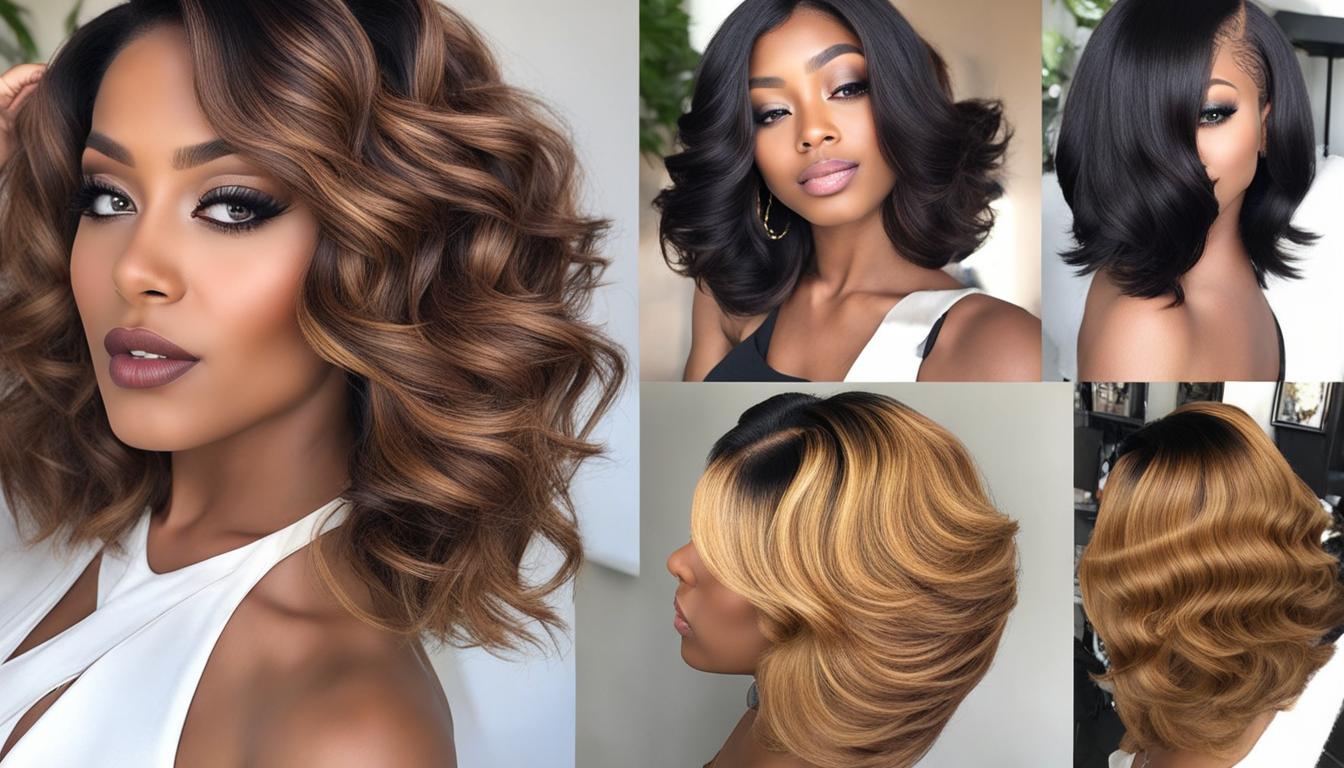
One of the benefits of lace wigs is their versatility. The lace base allows for easy customization, enabling wearers to part their hair anywhere they desire. This flexibility makes it possible to create different styles and experiment with various looks.
However, it’s important to note that lace wigs can be more expensive compared to other wig options. The intricate design and craftsmanship involved in creating lace wigs contribute to their higher price point. Additionally, the application and maintenance of lace wigs require time and skill. Proper application techniques, such as adhesive or wig tape, are necessary to secure the wig in place and ensure a natural-looking appearance.
In terms of comfort, breathability may be a concern with lace wigs. While the lace base allows for a realistic hairline, it can also limit airflow to the scalp. Proper scalp hygiene is crucial to prevent discomfort or scalp irritation, as well as to maintain the longevity of the wig.
When choosing a lace wig, it’s essential to consider the benefits of a natural and undetectable hairline, as well as the drawbacks of higher cost, application and maintenance requirements, and potential breathability issues. Ultimately, finding the right balance between style, comfort, and budget will help you make the best choice.
Exploring Mono Wigs
In the world of wigs, mono wigs, also known as monofilament wigs, stand out for their natural-looking hair parts. These wigs feature a unique cap construction made of sheer nylon mesh that provides a realistic scalp appearance, making it difficult for anyone to detect that you are wearing a wig. The monofilament material also allows for versatile styling, giving you the freedom to part your hair in any direction.
One of the main advantages of mono wigs is their lightweight and breathable design. The sheer cap construction ensures proper airflow, keeping your scalp cool and comfortable throughout the day. This makes mono wigs an excellent choice for individuals who prioritize comfort and breathability.
However, it’s important to note that mono wigs may not be as durable as other wig types. The sheer nylon mesh material is delicate, and over time, it may wear out or become damaged. To ensure your mono wig lasts as long as possible, it’s crucial to handle it with care and follow proper attachment techniques for a secure fit.
Key Features of Mono Wigs:
- Natural-looking hair parts
- Realistic scalp appearance
- Sheer nylon mesh cap construction
- Versatile styling options
- Lightweight and breathable
If you value a natural-looking hair part and scalp appearance, along with lightweight and breathable comfort, mono wigs are an excellent choice for you. Just remember to handle them with care and properly attach them for the best results.
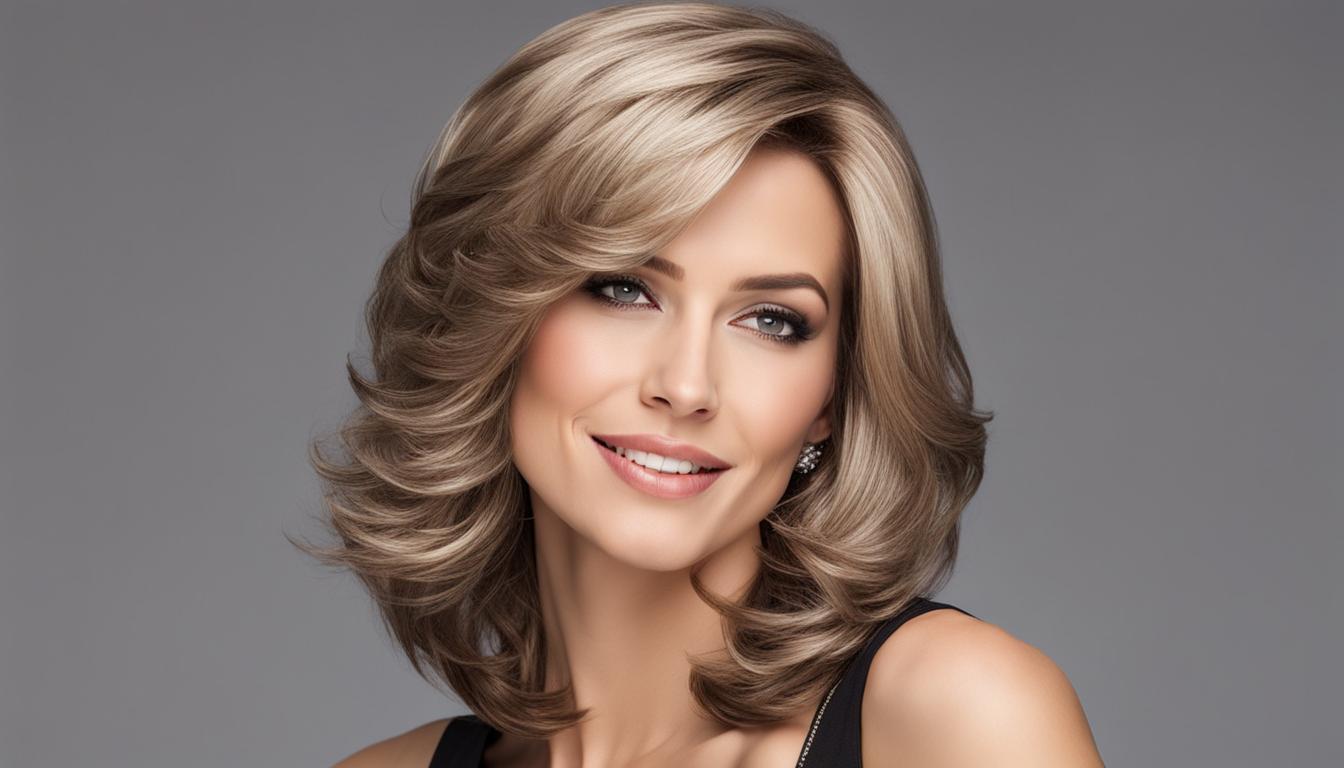
Understanding Hair Pieces and Toppers
When it comes to enhancing your hairstyle, hair pieces and toppers can be a game-changer. These versatile hair accessories are designed to cater to specific needs, offering additional volume or coverage to trouble spots. Whether you’re looking to add length, thickness, or cover thinning hair, hair pieces and toppers provide practical solutions for achieving your desired look.
There is a wide range of styles to choose from when it comes to hair pieces. Extensions are perfect for adding length and volume, while scrunchies offer a quick and easy way to create an updo. Ponytail hair pieces help you achieve a fuller and more voluminous ponytail effortlessly. If you’re looking for a subtle change, clip-in fringes can transform your hairstyle by adding a face-framing fringe.
On the other hand, hair toppers are specifically designed to target the scalp, providing coverage for thinning hair in specific areas. They are ideal for addressing hair loss around the crown, parting areas, hairlines, and temples. Hair toppers come in various sizes and styles, giving you the flexibility to blend seamlessly with your natural hair.
The Benefits of Hair Pieces and Toppers:
- Instantly add volume and length to your hair
- Cover thinning spots and areas of hair loss
- Enhance your hairstyle with ease and convenience
- Customize your look with different styles and colors
Whether you choose a hair piece or a topper, the attachment methods can vary. Some hair pieces utilize clips or combs for secure placement, while others may feature a wrap-around design for a more seamless look. The size of the hair piece also plays a role in achieving a natural appearance, as it should match your scalp area and blend seamlessly with your existing hair.
With hair pieces and toppers, you have the freedom to experiment with different styles, colors, and lengths without committing to a permanent change. They offer a versatile and customizable solution for anyone looking to enhance their hairstyle and boost their confidence.
| Hair Piece Type | Benefits |
|---|---|
| Extensions | Add length and volume |
| Scrunchies | Create quick updos |
| Ponytail Hair Pieces | Add fullness to ponytails |
| Clip-in Fringes | Transform your hairstyle with a fringe |
When it comes to hair toppers, they provide targeted coverage for thinning hair in specific areas. They blend seamlessly with your natural hair and can be attached using various methods such as clips, adhesive tapes, or integration with existing hair.
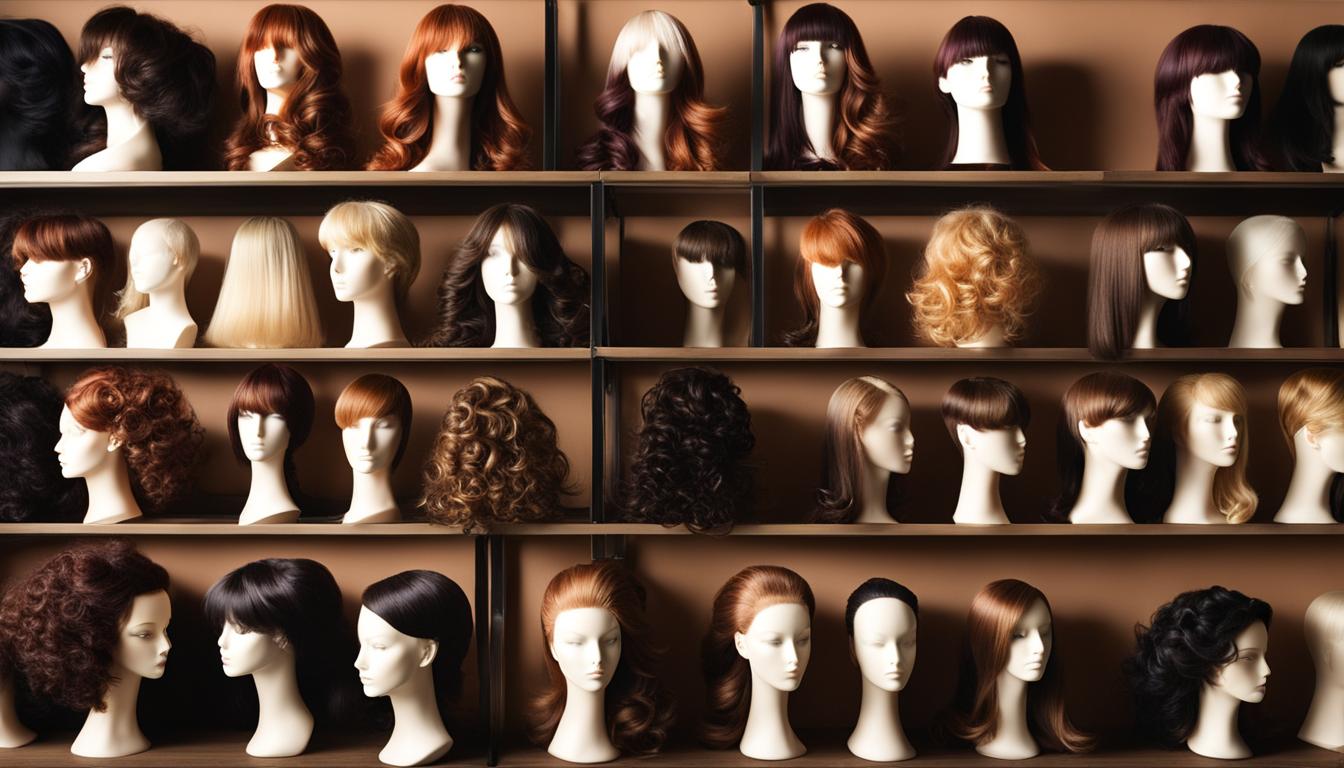
Whether you choose a hair piece or a topper, these versatile accessories provide endless possibilities for transforming your hairstyle. They allow you to experiment with different looks, boost your confidence, and enjoy the benefits of beautiful, voluminous hair.
Deciding Between Wigs and Hair Pieces
Choosing between wigs and hair pieces can be a personal decision that depends on the extent of coverage needed and individual preferences. Wigs are typically suitable for individuals experiencing complete hair loss or those seeking all-over coverage. On the other hand, hair pieces, such as hair toppers, are ideal for targeting specific areas of hair loss, providing coverage where it is needed most.
However, it’s important to note that there are exceptions to these general guidelines. Wigs can also be a great option for individuals with thinning hair, as they can provide the appearance of fullness and volume. Additionally, hair toppers can be used to enhance the volume and thickness of existing hair, making them a versatile choice.
When deciding between wigs and hair pieces, it’s important to consider your personal preferences, budget, and ease of use. Some individuals may prefer the convenience and versatility of wigs, while others may find hair pieces more comfortable and manageable. It’s also essential to evaluate your budget and determine which option aligns with your financial considerations.
Ultimately, the decision between wigs and hair pieces should be based on your unique needs and desired outcomes. Consider consulting with a hair professional or stylist who can provide guidance and recommendations based on your specific situation.
Take a moment to weigh the advantages and disadvantages of both options, and choose the one that best suits your coverage needs, style preferences, and overall lifestyle.
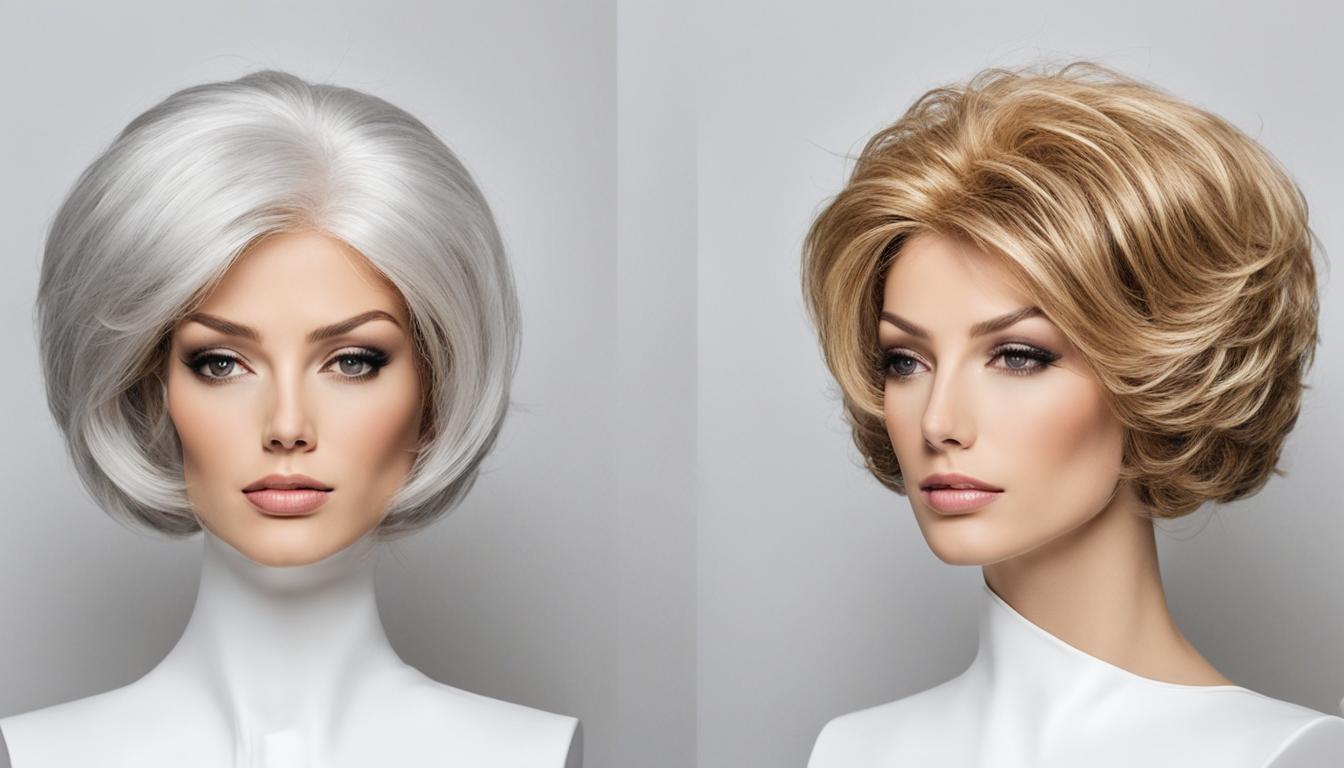
Conclusion
After exploring the wide variety of types of wigs and hairpieces, you can now make an informed decision to enhance your personal style. Factors such as wig cap construction, hair type, length, and texture should be taken into consideration, along with your personal preferences and budget. Whether you opt for a human hair wig, synthetic wig, lace wig, mono wig, or hair piece, you can find the perfect option for you.
By understanding the different types of wigs and hairpieces available, you can choose the one that suits your needs and desires. Human hair wigs offer a natural look and feel but require more care and maintenance. Synthetic wigs, on the other hand, are more affordable and offer long-lasting styles. Lace wigs provide an undetectable hairline, while mono wigs offer a realistic scalp appearance.
Remember to consider your desired style, level of coverage, and the convenience of use. Whether you want to transform your entire look or simply add volume to specific areas, there is a perfect wig or hair piece out there for you. Explore the possibilities and embrace the confidence that comes with finding the perfect wig or hairpiece that complements your individuality.
FAQ
What are the different types of wigs and hairpieces available?
There are different types of wigs and hairpieces available, including synthetic wigs, human hair wigs, lace front wigs, full lace wigs, heat resistant wigs, and monofilament wigs.
What are the benefits of human hair wigs?
Human hair wigs offer a natural look and feel, are highly durable, and can be styled and colored like natural hair.
What are the benefits of synthetic wigs?
Synthetic wigs are more affordable, hold their styles better, and are available in a wide range of colors.
What are the different wig cap constructions to choose from?
Wig cap constructions include lace front wigs, full lace wigs, U-part wigs, and monofilament caps.
What are the different hair types for wigs?
The different hair types for wigs include Indian human hair, virgin hair, Remy hair, and non-Remy hair.
How do I choose the right wig length and texture?
Consider your body type and personal preferences when selecting the length and texture of a wig.
What are the pros and cons of human hair and synthetic hair wigs?
Human hair wigs offer a natural look but require more care and maintenance, while synthetic hair wigs are more affordable but lack the natural shine and durability of human hair wigs.
What are the benefits and drawbacks of lace wigs?
Lace wigs provide a natural hairline and versatility in styling but can be more expensive and require skill for application and maintenance.
What are mono wigs?
Mono wigs, also known as monofilament wigs, feature a monofilament cap construction that allows for natural-looking hair parts.
What are hair pieces and hair toppers used for?
Hair pieces and hair toppers provide coverage for specific areas of the head, adding volume or covering trouble spots.
How do I decide between wigs and hair pieces?
Wigs are suitable for complete hair loss or all-over coverage, while hair pieces are ideal for targeting specific areas. Consider personal preferences, budget, and ease of use when deciding between the two.
What should I consider when exploring different types of wigs and hairpieces?
Consider factors such as wig cap construction, hair type, length, and texture, along with personal preferences and budget.

